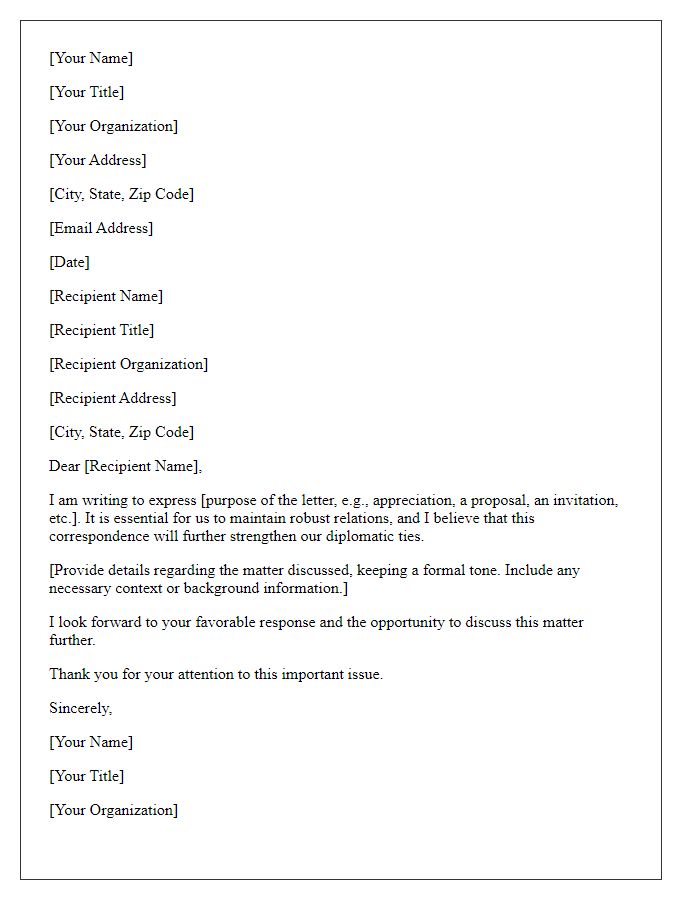Are you looking to craft the perfect diplomatic letter? Understanding the nuances of tone, structure, and decorum can make a significant difference in how your message is received. In our article, we'll explore key elements and templates that ensure your correspondence resonates with professionalism and respect. Join us as we dive deeper into the art of diplomacy and discover tips to elevate your communication skills!

Address and Salutation
Diplomatic correspondence requires a formal structure to convey respect and professionalism. The address typically includes the recipient's full name, title, and designation, followed by the name of the diplomatic mission or government department, and the complete mailing address. For example, when addressing a Foreign Minister, one might write: "His Excellency [Full Name], Minister of Foreign Affairs, [Country's] Ministry of Foreign Affairs, [Capital City], [Country]." A respectful salutation follows, such as "Excellency" or "Dear Minister," to reflect the formal nature of the communication. This structure aligns with international diplomatic etiquette, ensuring clear communication across diverse cultures.
Subject and Purpose
The subject of international diplomatic correspondence often encompasses key issues such as bilateral relations, trade agreements, or peace initiatives, aiming to foster communication between nations like the United States and China. The purpose of such correspondence is typically to convey messages of goodwill, negotiate terms of collaboration, or address concerns related to global security and humanitarian efforts. These exchanges usually take place during significant events like summits or conferences, highlighting the importance of diplomacy in resolving conflicts and promoting cooperation on platforms such as the United Nations. Each letter is meticulously crafted to reflect respect and formality, embodying the procedural norms of diplomatic etiquette.
Tone and Formal Language
Diplomatic correspondence requires a tone that is both formal and respectful, reflecting the importance of the communication and the relationships between entities. Proper etiquette is essential in conveying messages in international relations. A typical letter usually starts with the sender's address followed by the recipient's title and address. Salutations such as "Your Excellency" or "Honorable [Name]" are typically used. The body presents the key points clearly and concisely, ensuring that language remains neutral and professional, avoiding emotional appeals or informal expressions. Closing phrases like "Sincerely" or "Yours respectfully" precede the sender's name and title, adding to the formality of the document. Important historical context or relevant international agreements may also be included to enhance the content's depth and significance.
Closing and Signature
In diplomatic correspondence, closing remarks should maintain formality and respect. A typical closing may include expressions of gratitude and hope for continued cooperation, such as "I appreciate your attention to this matter" or "I look forward to your prompt response." The signature should reflect the sender's name, title, and organization, for instance, "John Smith, Ambassador of the United States," followed by the date and location of the document's creation, such as "Washington, D.C., October 25, 2023." This format embodies professionalism while fostering diplomatic relationships.
Relevant References and Protocol
Diplomatic correspondence requires adherence to established protocols and references to maintain formality and clarity. Key elements include the official titles of diplomats and dignitaries, such as "The Honorable" and their respective roles, for example, "Ambassador of the United States to France." Dates should follow international standards (ISO 8601 format) for clarity, such as "2023-10-12." Including the appropriate diplomatic symbols, like flags or seals, enhances the correspondence's significance. Furthermore, references to treaties, such as the 1961 Vienna Convention on Diplomatic Relations, provide context and authority, ensuring that communications reflect diplomatic norms and practices. Effective use of language that respects cultural nuances, including greetings and salutations in native languages, can also strengthen diplomatic relations.













Comments